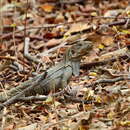Lifespan, longevity, and ageing
provided by AnAge articles
Maximum longevity: 10.2 years (captivity)
- license
- cc-by-3.0
- copyright
- Joao Pedro de Magalhaes
- editor
- de Magalhaes, J. P.
Biology
provided by Arkive
The Guatemala spiny-tailed iguana is a semi-arboreal species that rests in hollow branches or rock crevices (1). Like all iguanas, this species is active during the day (6), and will only venture out from its shelter in the morning once temperatures have reached comfortable levels (2). As a cold-blooded animal, the Guatemalan spiny-tailed iguana will find a nearby sunny area where it will bask in the sun's warmth until the optimum body temperature is reached (2); it can them begin the task of feeding.
The Guatemala spiny-tailed iguana is primarily a herbivore that feeds on plant material, but it may also occasionally capture small animal prey. Should it become threatened by the presence of a predator, the spiny-tailed iguana will rapidly flee to take refuge in a branch or rock crevice again (2).
During the breeding season, male spiny-tailed iguanas pursue females. When a female is caught, the male pins the female down with its front legs and holds her neck in its mouth and proceeds to copulate. Eight to ten weeks after mating, the female lays eggs into a nest she has dug into the ground (2). Like other iguanas, spiny-tailed iguanas exhibit no parental care, and the female will leave the nest once she has laid her eggs (6). Around 90 days later, the eggs hatch and the newly hatched iguanas must dig their way out of the underground nest (2).
Conservation
provided by Arkive
The Guatemalan spiny-tailed iguana does not currently receive any legal protection and is not known to occur within any protected areas, and thus action to prevent its extinction in the wild is clearly urgently needed (1). In 2007, the International Iguana Foundation initiated a campaign to raise funds for an Iguana Specialist Group workshop, aimed at the spiny-tailed iguanas, and to implement recommended conservation actions that arise from that workshop (7). Captive populations of the Guatemalan spiny-tailed iguana exist in several zoos around the world (1), which may act as an insurance against this species' entire extinction, yet this does not lessen how devastating it would be to lose this armoured reptile from the wild.
Description
provided by Arkive
This species belongs to the group of spiny-tailed iguanas of Mexico and Central America, (genus Ctenosaura), which are united by the possession of a spiky tail that can be used to defend itself (2). The Guatemalan spiny-tailed iguana has a relatively slender body that is greyish-brown with some blackish banding. It also exhibits a large dewlap, (a flap of skin that lies under the chin), that is more conspicuous in adult males than females, and a row of flattened spines runs along the centre of the back. Until 1997, the Guatemalan spiny-tailed iguana was considered the same species as Ctenosaura melanosterna, the Rio Aguan Valley iguana, but they were separated based on a number of differences in appearance (3).
Habitat
provided by Arkive
The Guatemalan spiny-tailed iguana is known to inhabit tropical dry forest in arid river valleys (1) (5), where it prefers rocky terrain (1).
Range
provided by Arkive
Occurs in the valley of the Río Motagua in south-eastern Guatemala, at elevations between 150 and 250 metres (3) (4).
Status
provided by Arkive
Classified as Critically Endangered (CR) on the IUCN Red List 2007 (1).
Threats
provided by Arkive
In the past, the Guatemalan spiny-tailed iguana has been heavily hunted for both food and the international pet trade (2). Collection for the pet trade continues today, but is not believed to pose such as serious threat as habitat loss (1). The conversion of forest habitat into agricultural land is the greatest threat to the survival of the Guatemalan spiny-tailed iguana (1) (7); the impacts of which are exacerbated by this species' restricted distribution. (1).
Distribution
provided by ReptileDB
Continent: Middle-America
Distribution: SE Guatemala (valley of the Rio Motagua).
Type locality: Gualan, Guatemala
Ctenosaura palearis
provided by wikipedia EN
Ctenosaura palearis, commonly known as the Motagua spiny-tailed iguana, is a species of spiny-tailed iguana endemic to the Motagua Valley in Guatemala.
Conservation status
This species is threatened by habitat loss and illegal trade. These iguanas were used as a source of food by natives. Its eggs are a food source for the equally threatened Motagua Valley beaded lizard (Heloderma charlesbogerti), thereby possibly linking the status of the two species. It is included in CITES appendix II so that trade of this species is regulated.[1]
Diet
The Guatemalan spiny-tailed iguana feeds on leaves and the fruits of the cactus Stenocereus pruinosus and occasionally insects (crickets, beetles, ants and wasps).
Habitat
The habitat of C. palearis is characterized by a greater frequency of the cactus Stenocereus pruinosus, Albizzia idiopoda, Ximena americana and Acacia deamii. The Guatemalan spiny-tailed iguana can be regarded as a keystone species because it plays an important role in seed dispersal of S. pruinosus.
References
- Coti, P. and D. Ariano. 2008. Ecology and traditional use of the Guatemalan black iguana (Ctenosaura palearis) in the dry forests of the Motagua Valley, Guatemala. Iguana 15 (3): 142–149.[1]
- license
- cc-by-sa-3.0
- copyright
- Wikipedia authors and editors
Ctenosaura palearis: Brief Summary
provided by wikipedia EN
Ctenosaura palearis, commonly known as the Motagua spiny-tailed iguana, is a species of spiny-tailed iguana endemic to the Motagua Valley in Guatemala.
- license
- cc-by-sa-3.0
- copyright
- Wikipedia authors and editors

